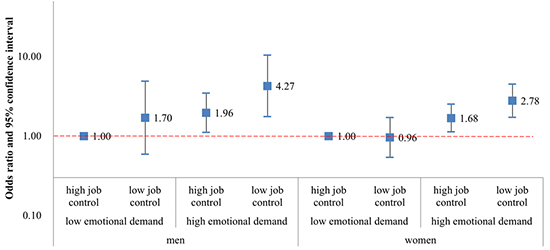1. Totterdell P, Holman D. Emotion regulation in customer service roles: testing a model of emotional labor. J Occup Health Psychol. 2003; 8:55–73.
2. Lewig KA, Dollard MF. Emotional dissonance, emotional exhaustion and job satisfaction in call centre workers. Eur J Work Organ Psychol. 2003; 12:366–392.
3. Zapf D. Emotion work and psychological well-being: a review of the literature and some conceptual considerations. Hum Resour Manage Rev. 2002; 12:237–268.
4. Härmä M, Kompier MA, Vahtera J. Work-related stress and health--risks, mechanisms and countermeasures. Scand J Work Environ Health. 2006; 32:413–419.
5. Grandey AA. Emotion regulation in the workplace: a new way to conceptualize emotional labor. J Occup Health Psychol. 2000; 5:95–110.
6. Hochschild AR. The Managed Heart: Commercialization of Human Feeling (Twentieth Anniversary Edition With a New Afterword). Berkeley (CA): University of California Press;2003.
7. Demerouti E, Bakker AB, de Jonge J, Janssen PP, Schaufeli WB. Burnout and engagement at work as a function of demands and control. Scand J Work Environ Health. 2001; 27:279–286.
8. Castanheira F, Chambel MJ. JD-C model to explain burnout in frontline workers: the useful contribution of emotional demands. Hum Factors Ergon Manuf Serv Ind. 2013; 23:412–423.
9. Sterud T, Hem E, Lau B, Ekeberg O. Suicidal ideation and suicide attempts in a nationwide sample of operational Norwegian ambulance personnel. J Occup Health. 2008; 50:406–414.
10. Yoon SL, Kim JH. Job-related stress, emotional labor, and depressive symptoms among Korean nurses. J Nurs Scholarsh. 2013; 45:169–176.
11. Lynch TR, Cheavens JS, Morse JQ, Rosenthal MZ. A model predicting suicidal ideation and hopelessness in depressed older adults: the impact of emotion inhibition and affect intensity. Aging Ment Health. 2004; 8:486–497.
12. Yoon JH, Lee KH, Hahn KY, Chang SJ, Cha BS, Min SH, Lee KS, Chae HS, Eom A, Koh SB. Suicide trend of standardized mortality ratio and age standardized proportion mortality ratio according to occupational groups in Korea: 1993-2007. Korean J Occup Environ Med. 2011; 23:173–182.
13. Kessler RC, Borges G, Walters EE. Prevalence of and risk factors for lifetime suicide attempts in the National Comorbidity Survey. Arch Gen Psychiatry. 1999; 56:617–626.
14. Siu C, Yuen SK, Cheung A. Burnout among public doctors in Hong Kong: cross-sectional survey. Hong Kong Med J. 2012; 18:186–192.
15. Karasek RA, Theorell T, Schwartz JE, Schnall PL, Pieper CF, Michela JL. Job characteristics in relation to the prevalence of myocardial infarction in the US Health Examination Survey (HES) and the Health and Nutrition Examination Survey (HANES). Am J Public Health. 1988; 78:910–918.
16. Laschinger HK, Havens DS. The effect of workplace empowerment on staff nurses' occupational mental health and work effectiveness. J Nurs Adm. 1997; 27:42–50.
17. Kang SH, Boo YJ, Lee JS, Han HJ, Jung CW, Kim CS. High occupational stress and low career satisfaction of Korean surgeons. J Korean Med Sci. 2015; 30:133–139.
18. Tsutsumi A, Kayaba K, Ojima T, Ishikawa S, Kawakami N, Grp JM; Jichi Medical School Cohort Study Group. Low control at work and the risk of suicide in Japanese men: a prospective cohort study. Psychother Psychosom. 2007; 76:177–185.
19. Häusser JA, Mojzisch A, Niesel M, Schulz-Hardt S. Ten years on: a review of recent research on the job demand–control (-support) model and psychological well-being. Work Stress. 2010; 24:1–35.
20. Yoon JH, Chang SJ. 0130 The combined effects of high emotional demands and low job control at work on suicidal ideation in Korean sales and service workers. Occup Environ Med. 2014; 71:A76–7.
21. Yoon JH, Won JU, Lee W, Jung PK, Roh J. Occupational noise annoyance linked to depressive symptoms and suicidal ideation: a result from nationwide survey of Korea. PLoS One. 2014; 9:e105321.
22. Seok H, Yoon JH, Lee W, Lee JH, Jung PK, Kim I, Won JU, Roh J. The association between concealing emotions at work and medical utilization in Korea. Ann Occup Environ Med. 2014; 26:31.
23. Nishimura M, Terao T, Soeda S, Nakamura J, Iwata N, Sakamoto K. Suicide and occupation: further supportive evidence for their relevance. Prog Neuropsychopharmacol Biol Psychiatry. 2004; 28:83–87.
24. Stallones L, Doenges T, Dik BJ, Valley MA. Occupation and suicide: Colorado, 2004-2006. Am J Ind Med. 2013; 56:1290–1295.
25. Kelly S, Charlton J, Jenkins R. Suicide deaths in England and Wales, 1982-92: the contribution of occupation and geography. Popul Trends. 1995; 16–25.
26. Kposowa AJ. Suicide mortality in the United States: differentials by industrial and occupational groups. Am J Ind Med. 1999; 36:645–652.
27. Yoon JH, Junger W, Kim BW, Kim YJ, Koh SB. Investigating the time lag effect between economic recession and suicide rates in agriculture, fisheries, and forestry workers in Korea. Saf Health Work. 2012; 3:294–297.
28. Zapf D, Seifert C, Schmutte B, Mertini H, Holz M. Emotion work and job stressors and their effects on burnout. Psychol Health. 2001; 16:527–545.
29. Iacovides A, Fountoulakis KN, Kaprinis S, Kaprinis G. The relationship between job stress, burnout and clinical depression. J Affect Disord. 2003; 75:209–221.
30. Dyrbye LN, Thomas MR, Massie FS, Power DV, Eacker A, Harper W, Durning S, Moutier C, Szydlo DW, Novotny PJ, et al. Burnout and suicidal ideation among U.S. medical students. Ann Intern Med. 2008; 149:334–341.
31. Kposowa AJ. Unemployment and suicide: a cohort analysis of social factors predicting suicide in the US National Longitudinal Mortality Study. Psychol Med. 2001; 31:127–138.
32. Park SC, Lee SK, Oh HS, Jun TY, Lee MS, Kim JM, Kim JB, Yim HW, Park YC. Hazardous drinking-related characteristics of depressive disorders in Korea: the CRESCEND study. J Korean Med Sci. 2015; 30:74–81.
33. Ko MJ, Lee EY, Kim K. Relationship between socioeconomic position and suicide attempts among the Korean adolescents. J Korean Med Sci. 2014; 29:1287–1292.
34. Kim J, Oh J. Characteristics of self-injury, suicide by sex, age, educational attainments and occupation. J Korean Soc Emerg Med. 2014; 25:152–158.







 PDF
PDF ePub
ePub Citation
Citation Print
Print





 XML Download
XML Download